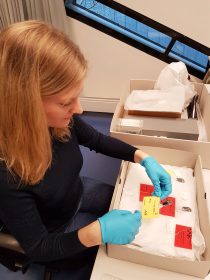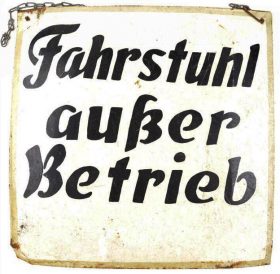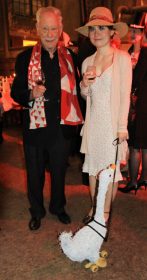Object Lessons on our Museum’s History
I still remember my first day of work at the museum well, some months ago. Together with two new colleagues, I rode the elevator one floor down, we passed through two secured doors, and there we were: in the warehouse. There on two iron shelves towered bulging boxes and cartons as well as all kinds of objects — and with them, my job for the next eight months as an academic volunteer at the Jewish Museum Berlin: to set up a little special exhibition on the history of the museum itself.
Somewhat at a loss, I rummaged through a hodgepodge of exhibition papers, invitations, and photographs of people I didn’t know, and asked myself what a wire-frame goose on skateboard wheels or an old elevator sign were doing in a museum.
Mazel Tov!
In September of 2016 the Jewish Museum Berlin celebrated the 15-year anniversary of its existence. Its background reaches, however, all the way back into the 1970s. The idea of founding a Jewish museum arose during an exhibition on the 300-year existence of the Jewish congregation at the then Berlin Museum. 30 years would pass before our museum opened its doors in 2001. Since then, the JMB has been host to countless exhibitions and events, employees have come and gone, and through refurbishments as well as new construction, not only the space but also the museum’s scope of functions has constantly expanded (further information about the history of the museum on our website).
Myriad objects are witness to all these developments, items that have simply accumulated over the years rather than having been strategically collected. Many museum employees have at one time or another brought something to the warehouse that seemed important to them; others have collected memorabilia in their offices.
Museum meets city history
First I needed an overview. “What do we have?” and “Of that, what do we want to keep?” were two of the questions I wanted to answer. To generate some structure, I also classed the objects according to subject.
One of these subjects, for example, was the museum’s building and thus, objects related to it: a number of signs from the former central floral market hall across from the museum, among which was the elevator sign. Those told the story of the contact point between Berlin’s urban history and the history of our house. From the end of the 19th century flowers were sold at this location. Today the 1965 hall houses our W. Michael Blumenthal Academy together with the library and archive, among other things. In the next few years, a children’s museum is also to arise on this site.
The “historical” accessory
I was able to clarify the history of the wire-frame goose too: the museum’s 10th anniversary was celebrated with a masked ball for employees. The goose was part of the costume that won a student intern at the time the first prize in a costume contest. Her model was a photograph from our collection with the title, “Women strolling with goose,” which had served as the leading motif for a 2008 exhibition about the photographer Ruth Jacobi. Thus the goose established connections to a variety of topics on museum history: employees, exhibitions, and the collection itself.
Each item that we have, whether flyer, keychain, or badge, gets inventoried. All the information on the object is entered into a data bank and it receives a number, description, measurements, gets photographed, and tagged. Around 500 objects in our internal databank already have the tag “History of the Jewish Museum Berlin.” As long as the museum exists, more will be added. In this sense then: to the next 15 years!
After working eight months in the collection, Lisa Renner now supports the team “new permanent exhibition”.


